Care

Caring for Your Fine Linens
Luxury linens deserve proper care to maintain their beauty and longevity. Follow these guidelines to ensure years of enjoyment.
Care Instructions by Fabric
Each fiber requires special attention. Select your fabric type from the menu below for detailed care instructions.
General Care Tips
- Choose Quality Cleaners: If sending linens out, ensure they use clean water and a neutral detergent.
- Hard or Well Water? Send linens to a professional service with proper instructions—fine sediment can cause premature wear.
- Pressing Matters: Ironing smooths fibers and reduces friction points, helping linens last longer. Avoid starch, as it weakens fabric over time.
- Pillowcase Protection: Facial stubble acts like tiny razors. If you or your partner have 5 o’clock shadow, consider ordering extra pillowcases to extend their lifespan.
- Preventing Pilling: Our fine cotton does not pill unless exposed to down or feather allergies—check your bedding materials if pilling occurs.
📄 Need a PDF of care instructions? Contact us for a copy in English or Spanish.
👉 Select your fabric type below for specific care instructions.
Care for Kearsley Linen
👉 For specific care instructions, select your fabric type below.
✅ Use Cool Water & Gentle Detergent
Wash in cool water with a mild detergent that contains no perfumes, dyes, alkali, bleaches, or optical brighteners—these additives can weaken fibers, fade colors, or damage embroidery.
Avoid fabric softeners—they clog fibers, reduce breathability, and can trigger allergies.
✅ No Need for Hot Water to Disinfect
Hot water is not necessary for disinfection. Instead, add one cup of white vinegar to the rinse cycle—it naturally disinfects, brightens fabrics, and helps soften them without leaving residue.
✅ Dry Gently & Avoid Heat Damage
Use a cool dryer setting and remove linens just before fully dry to prevent brittleness.
Over-drying or using hot water/hot dryers can shock fibers, making them brittle. While steaming can help recover them, it’s best to prevent damage in the first place.
Air drying is ideal. If using a dryer, keep it cool to avoid shrinkage.
✅ Preserving Smoothness & Longevity
Ironing while linens are still slightly damp restores their luxurious smoothness.
Alternatively, spread linens on a bed and smooth them by hand for a crisp, natural finish.
✅ Professional Laundering
A great option if no harsh chemicals are used—choose a trusted service carefully.
✅ Initial Washes & Natural Shrinkage
Wash and dry 3-4 times to allow linens to reach their correct size. Our expert team calculates for natural fiber shrinkage as precisely as possible.
👉 For specific care instructions, select your fabric type below.
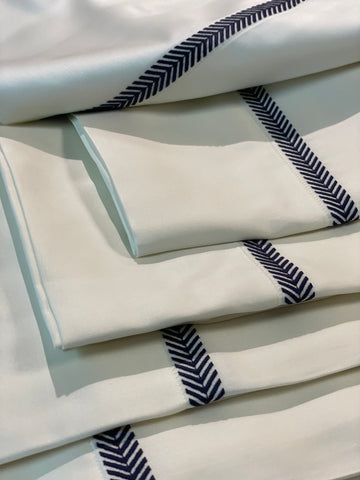
However, some clients with properly filtered water successfully hand-wash their cashmere shams, ponchos, bed scarves, throw blankets, and wraps using the following method:
✔ Wash on a cool, ultra-gentle hand wash cycle.
✔ Use a high-quality cashmere wash or a scent- and color-free biodegradable detergent.
✔ Air dry flat, blocking on towels to maintain shape.
Many find this method effective and then send their pieces to a trusted, high-quality dry cleaner as needed for touch-ups.
🔹 Choosing the Right Professional Care
For best results, select a dry cleaner experienced with fine cashmere and luxury textiles. While we offer guidance, Kearsley cannot guarantee results from home laundering or professional cleaning services.
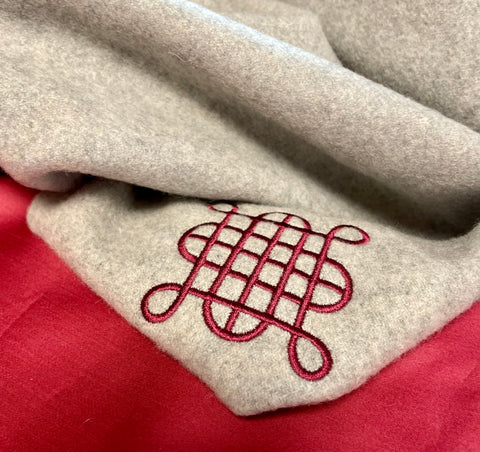
A PDF version of these care instructions is available in English and Spanish below. Perfect for your laundry room, household manual, or yacht care guide.
✔ Wash Before Use – A Vital Step
Washing 2-3 times before first use is essential—this process tightens the weave, reducing the likelihood of snagging and improving absorbency.
✔ Use Cool Water & Gentle Detergent
Wash with cool water and a mild detergent that is free of perfumes, dyes, alkali, bleaches, and optical brighteners—these additives can weaken fibers, affect color, and damage embroidery.
✔ No Need for Hot Water to Disinfect
Hot water is unnecessary and can weaken fibers over time.
Instead, add 1 cup of white vinegar to the rinse cycle—this naturally disinfects, softens the fabric, and removes detergent residue without reducing absorbency like fabric softeners do.
✔ Prevent Snags & Damage
Check your laundry for open zippers, Velcro, or rough items that could snag the terry loops.
Avoid fabric softeners—they coat fibers, making towels less absorbent.
✔ Drying for Optimal Softness
Tumble dry completely. During this process, the terry will naturally compact, making it less prone to snagging.
✔ Handling Snags
Snagging may still occur before the first washes—if a thread pulls, simply snip it off; it will not unravel.
👉 Follow these simple steps to keep your terry towels and robes soft, absorbent, and beautiful for years to come.

For your convenience, a PDF version of these care instructions is available in English and Spanish below. We recommend printing it for your laundry room, household manual, or yacht care guide.
✔ Washing & Detergent Guidelines
Wash with cool water and a gentle detergent that is free of perfumes, dyes, alkali, bleaches, and optical brighteners—these additives can weaken fibers, affect color, and damage embroidery.
Do not use fabric softeners—they coat fibers and reduce breathability.
✔ No Need for Hot Water to Disinfect
Hot water is unnecessary and can weaken fibers over time.
Instead, add 1 cup of white vinegar to the rinse cycle—this naturally disinfects, brightens fabric, and softens fibers without leaving residue or reducing breathability.
✔ Drying Instructions
Hang to dry only.
Do NOT use a dryer—matelassé and piqué fabrics will shrink if tumble dried.
If you plan to machine dry your linens, be sure to select a larger size to accommodate shrinkage.
✔ Optional Pre-Shrinking Service
If you plan to wash and dry your items, please inform Kearsley in advance.
For a fee, Kearsley can wash, dry, and press your linens three times before delivery to ensure pre-shrinkage.
✔ Maintaining Texture & Appearance
If machine washed, matelassé and piqué will naturally develop a beautifully textured, puckered look.
If you prefer a crisp, smooth finish, simply iron them to restore their original appearance.
✔ Professional Cleaning Option
Dry cleaning is a good alternative if the service uses gentle, chemical-free methods.
👉 Follow these care instructions to keep your matelassé and piqué bed covers and shams looking luxurious for years to come.
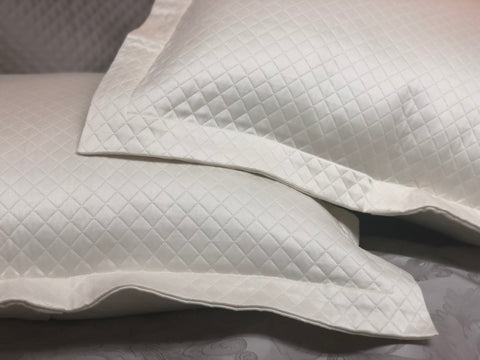
For your convenience, a PDF version of these care instructions is available in English and Spanish below. We recommend printing it for your laundry room, household manual, or yacht care guide.
✔ Washing & Detergent Guidelines
Wash with cool water and a gentle detergent that is free of perfumes, dyes, alkali, bleaches, and optical brighteners—these additives can weaken fibers, fade colors, and damage embroidery.
Do not use fabric softeners—they coat fibers, reducing breathability and absorbency.
✔ No Need for Hot Water to Disinfect
Hot water is unnecessary and can weaken linen fibers over time.
Instead, add 1 cup of white vinegar to the rinse cycle—this naturally disinfects, brightens fabric, and softens fibers without leaving residue or affecting absorbency.
✔ Drying Instructions
Line drying is best—hang on a rod or line to allow natural airflow.
If using a dryer, select the gentlest heat setting and remove linens before fully dry to prevent over-drying and brittleness.
✔ Pressing & Starch Use
Pressing is necessary to restore the linen’s crisp, fresh appearance.
Starch is optional—it is not required but may be used if preferred.
✔ Professional Laundering Option
An excellent choice as long as no harsh chemicals are used.
👉 Follow these care instructions to keep your fine linen looking pristine for years to come.
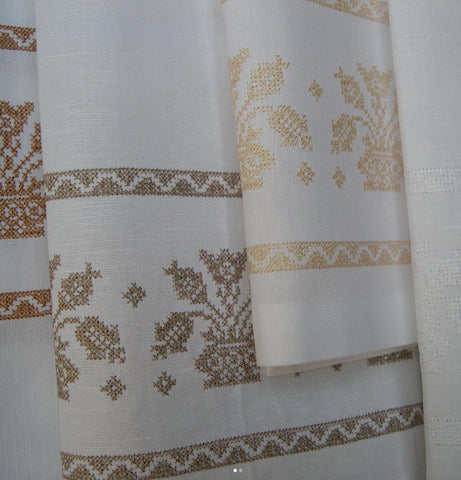
For your convenience, a PDF version of these care instructions is available in English and Spanish below. We recommend printing it for your laundry room, household manual, or yacht care guide.
Proper care will maintain their softness and signature weave.
Washing Instructions
✔ For large blankets, use only large-capacity, front-loading washers without agitators. If unavailable, professional laundering is recommended to protect the weave and prevent damage.
✔ Wash in cold water on a gentle cycle with a mild detergent free from perfumes, dyes, alkali, bleaches, or optical brighteners, as these can weaken fi bers and affect texture.
✔ Avoid fabric softeners. Instead, add a few drops of olive oil and/or lavender essential oil to a soft cloth and place it in the dryer during the gentle drying cycle.
✔ White vinegar is a natural softener, brightener, and disinfectant. Add one cup to the rinse cycle to remove detergent residue and maintain the fabric’s natural breathability.
Drying & Finishing
✔ Air drying is recommended to maintain texture and prevent shrinkage.
✔ If using a dryer, tumble dry on low heat and remove while slightly damp to prevent overdrying.
✔ Waffle weave fabric naturally contracts after washing, creating a more pronounced texture. If a smoother look is desired, gently stretch the fabric while damp before drying.
✔ Ironing is not necessary as the textured weave enhances its natural aesthetic. However, for a sleeker appearance, use a low-heat setting with steam.
Stain Removal
✔ Protein-based stains (blood, wine, food): Place fabric on a clean cloth, carefully pour hydrogen peroxide directly on the stain, and dab with a clean cloth to lift it.
✔ Oil-based stains: Sprinkle baking soda or cornstarch on the stain, let it absorb the oil, then brush off gently before washing.
✔ Ink stains: Dab with rubbing alcohol on a clean cloth to remove the mark.
✔ Avoid washing in machines with agitators, as they can snag and prematurely wear the delicate waffle weave.
✔ Large blankets require ample space to wash and dry properly. If a large-capacity washer and dryer are not available, send them out for professional laundering to ensure thorough yet gentle cleaning.
✔ Water quality matters. Hard water or unfi ltered, silty well water can cause premature wear. Chlorinated city water may fade colors over time.
✔ Proper care will preserve the soft, airy structure of the weave, ensuring it remains cozy and breathable
👉 Follow these instructions for proper care to preserve their softness, signature weave, and keep your fine linen looking pristine for years.
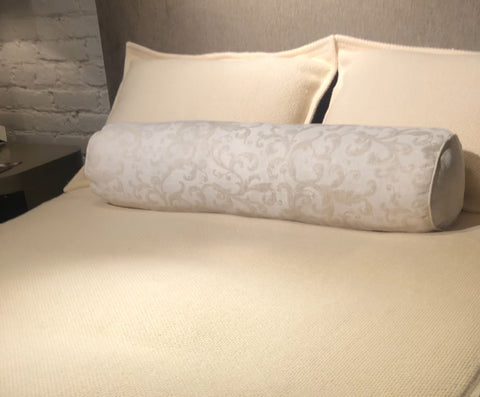
Proper care ensures that down pillows and duvets remain lofty, clean, and long-lasting. While Kearsley has made exceptional down bedding in the past and plans to do so again, we currently source from trusted brands or refer designers to our preferred manufacturers.
Regular Maintenance
✔ Dry pillows on high heat with clean tennis balls for at least 15 minutes once a month to restore loft and kill dust mites.
✔ Hot sleepers should dry pillows more frequently, as moisture from sweat and breath creates an environment where dust mites thrive.
✔ Shake duvets daily to keep the down evenly distributed and aired out.
Washing & Drying
✔ Wash pillows and duvets 2-4 times per year with white vinegar in the rinse cycle to break down residue and refresh the fill.
✔ Use a large-capacity front-loading washer on a gentle cycle with mild detergent (no bleach, optical brighteners, or fabric softeners).
✔ Rinse thoroughly to remove all soap, as detergent buildup can cause clumping.
✔ Fully dry on low heat with clean tennis balls or wool dryer balls, as damp down can develop mildew. This process may take several drying cycles to ensure complete dryness.
✔ Do not air dry—down must be completely dry before use.
Why Proper Care is Important
✔ Most people who believe they are allergic to down are actually allergic to dust mites, which thrive in moist, dark environments like pillows.
✔ 15 minutes of hot drying eliminates dust mites.
✔ Synthetic pillows are NOT more hypoallergenic—they trap heat, retain moisture, and harbor dust mites 8 times more than down.
✔ Higher feather content blocks airflow and reduces breathability. True high-quality down pillows contain minimal feathers, while many products labeled "100% down" legally contain up to 15% feathers.
👉 Follow these care instructions to keep your down pillows & Duvets looking luxurious for years to come.
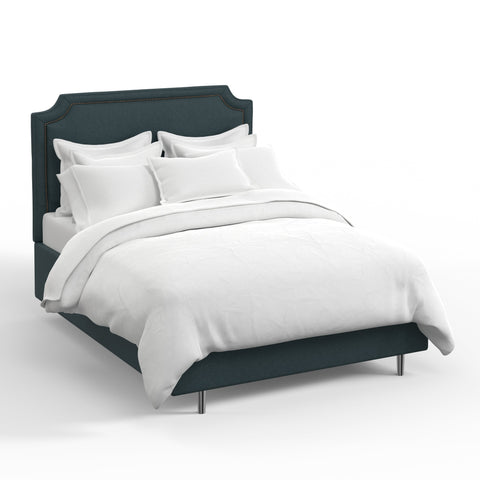
Kearsley’s cotton and linen jacquard duvets and shams are crafted from the fi nest materials, designed for luxurious texture and longevity. Proper care ensures they remain beautiful and soft for years to come.
Washing Instructions
✔ For large duvets, use only large-capacity, front-loading washers without agitators. If unavailable, professional laundering is recommended to protect the fabric and maintain its structure.
✔ Wash in cold water on a gentle cycle with a mild detergent free from perfumes, dyes, alkali, bleaches, or optical brighteners, as these can weaken fi bers and alter color.
✔ Do not use fabric softeners. Instead, add a few drops of olive oil and/or lavender essential oil to a soft cloth and place it in the dryer during the gentle drying cycle.
✔ White vinegar is a natural softener, brightener, and disinfectant. Add one cup to the rinse cycle to remove detergent residue, refresh the fabric, and prevent stiffness.
Drying & Finishing
✔ Air drying is recommended to maintain texture and prevent shrinkage.
✔ If using a dryer, tumble dry on low heat and remove while slightly damp.
✔ Lay duvets and shams fl at or on the bed to finish drying naturally. This preserves the jacquard texture and prevents excessive wrinkling.
✔ For a smoother fi nish, iron while damp on a low to medium setting, or use a steamer. Professional laundering will restore a crisp, original look.
Stain Removal
✔ Protein-based stains (blood, wine, food): Place fabric on a clean cloth, carefully pour hydrogen peroxide directly on the stain, and dab with a clean cloth to lift it.
✔ Oil-based stains: Sprinkle baking soda or cornstarch on the stain, let it absorb the oil, then brush off gently before washing.
✔ Ink stains: Dab with rubbing alcohol on a clean cloth to remove the mark.
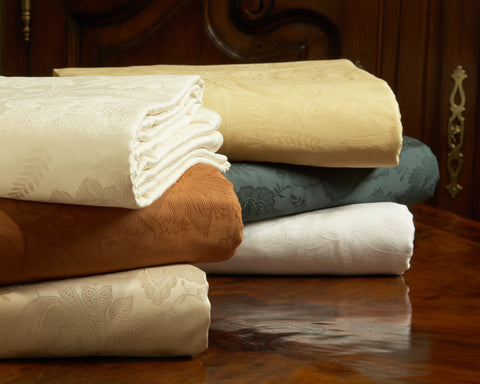
Hemp is a strong, breathable, and naturally antimicrobial fabric that softens beautifully over time. Follow these care instructions to maintain its durability and luxurious texture.
Washing Instructions
✔ Wash in cool to warm water with a gentle detergent free from perfumes, dyes, alkali, bleaches, or optical brighteners, as these can weaken fi bers and affect color.
✔ Use a gentle cycle with plenty of water to allow the fabric to move freely.
✔ Avoid fabric softeners. Instead, add a few drops of olive oil and/or lavender essential oil to a soft cloth and place it in the dryer during the gentle drying cycle.
✔ White vinegar is a natural softener, brightener, and disinfectant. Add one cup to the rinse cycle to remove detergent residue, soften the fabric, and refresh linens.
✔ Do not overdry. Hemp dries quickly and should be removed from the dryer while slightly damp to prevent excessive wrinkling and preserve the fabric’s softness.
✔ For best results, iron while damp or simply smooth the fabric by hand and allow it to air dry fully.
Stain Removal
✔ Protein-based stains (blood, wine, food): Place fabric on a clean cloth, carefully pour hydrogen peroxide directly on the stain, and dab with a clean cloth to lift the stain.
✔ Oil-based stains: Sprinkle baking soda or cornstarch on the stain, let it absorb the oil, then brush it off gently before washing.
✔ Ink stains: Place fabric on a clean cloth, carefully pour rubbing alcohol on the stain, and dab with a clean cloth to remove the mark.
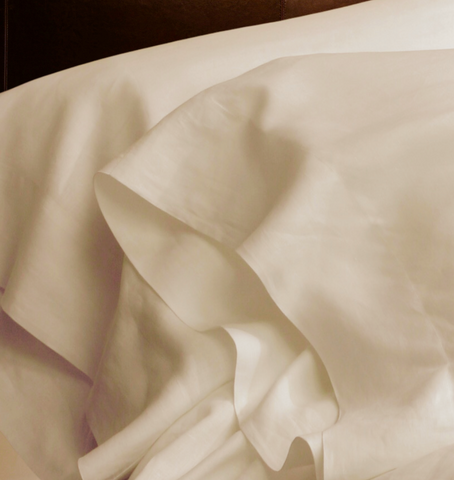
Fine Linen Care Essentials
Clean Laundry, Beautiful Linens: Our Product Recommendations
All selections are fragrance-free, dye-free, hormone-disruptor-free, and made in the USA or Canada.
Safe for You, Your Home, and the Planet—Without Compromising Performance
We’ve curated this list of laundry detergents and care products not only for their clean, non-toxic ingredients and eco-conscious packaging, but also because they perform beautifully. Every item is gentle on the finest natural fibers—including Giza and Egyptian cotton—and safe for your skin, your family, and your home. You don’t have to sacrifice effectiveness to protect your health and the planet.
Disclosure: As an Amazon Associate, Kearsley earns from qualifying purchases. Some links are affiliate. We choose products for quality and fit with our care guidance, not for commission. Your price does not change.
✔ Highest cleaning power of all Tru Earth formulas
✔ Free from fragrance, dyes, parabens, and hormone disruptors
✔ Safe for sensitive skin and effective on heavily soiled laundry
✔ Strongest performer while maintaining full safety standards
View Product (Affiliate)
2. Tru Earth Baby Eco-Strips – Fragrance-Free (Made in Canada)
✔ Safest formula, designed for newborns and highly sensitive skin
✔ Exceptionally gentle and non-toxic
✔ Best choice for delicate items, underwear, and those with multiple chemical sensitivities
✔ A bit less powerful on tough stains but ideal for daily use
View Product (Affiliate)
3. Molly’s Suds Laundry Detergent Sheets – Unscented (Made in USA)
✔ Free of harsh chemicals, fragrances, dyes, and optical brighteners
✔ Made with minimal ingredients and designed for skin safety
✔ Gentle yet effective for everyday loads
✔ Reputable brand known for toxin-free laundry care
View Product (Affiliate)
(Made in USA)
✔Exceptionally clean formula: coconut oil soap, baking soda, washing soda
✔No synthetic fragrance, preservatives, brighteners, or dyes
✔MADE SAFE and EWG Verified
✔Plastic-free and refillable packaging
✔Powerful yet gentle—perfect for high-end natural fibers
View Product (Affiliate)
2. Molly’s Suds Original Laundry Powder – Unscented(Made in USA)
✔Simple, earth-derived ingredients: baking soda, salt, washing soda
✔Free of fragrance, optical brighteners, dyes, and harsh chemicals
✔Excellent for baby clothes, cloth diapers, and sensitive skin
✔Strong cleaning without residue
View Product (Affiliate)
3. AspenClean Laundry Pods – Unscented (Made in Canada)
✔EWG Verified and formulated without fragrance, dyes, or harmful chemicals
✔Plant- and mineral-based, biodegradable and hypoallergenic
✔Pre-measured pods make laundry simple, clean, and mess-free
✔Safe for sensitive skin, babies, and delicate fabrics including fine cotton linens
✔Free from chlorine, phosphates, optical brighteners, and petroleum-based ingredients
View Product (Affiliate)
✔ Ultra-concentrated (10x) plant-based formula
✔ No sulfates, parabens, dyes, or synthetic fragrances
✔ Hypoallergenic, biodegradable, and greywater-safe
✔ Designed by chemists and pediatricians
✔ Excellent stain removal without toxic ingredients
View Product (Affiliate)
2. ATTITUDE Laundry Detergent – Fragrance-Free
(Made in Canada)
✔ Dermatologist-tested and EWG Verified
✔ Made from plant- and mineral-based ingredients
✔ Free from dyes, fragrances, optical brighteners, and formaldehyde
✔ Great for sensitive skin, babies, and those with chemical sensitivities
✔ Eco-conscious packaging and company ethics
View Product (Affiliate)
3. ECOS Hypoallergenic Laundry Detergent – Free & Clear (Made in USA)
✔ EPA Safer Choice Certified
✔ No synthetic fragrance, dyes, or optical brighteners
✔ Plant-powered and pH balanced
✔ Good general-purpose option for sensitive skin and family households
✔Readily biodegradable and greywater system compatible
View Product (Affiliate)
Only when needed:
Dirty Labs Bio Enzyme Laundry Booster – Scent Free (Made in USA)
✔ A non-toxic, fragrance-free booster that’s safe for luxury linens, including fine Egyptian and Giza cotton.
✔ Uses protease and amylase enzymes to break down stains from sweat, body oils, makeup, and sunscreen—without bleach, sulfates, dyes, or optical brighteners.
pH-balanced and biodegradable, it won’t strip fibers or leave dulling residues.
✔ Ideal when paired with gentle detergents like Puracy or ATTITUDE.
✔ Use a small dose in cold or warm water for best results on delicate linens.
View Product (Affiliate)
These clean, non-chlorine bleach alternatives offer powerful brightening and stain-fighting without damaging delicate natural fibers. Ideal for use alongside gentle detergents in both standard and HE machines.
1. Meliora Oxygen Brightener – Fragrance-Free (Made in USA)
✔ Ingredients: Sodium percarbonate (oxygen bleach), washing soda
✔ No synthetic fragrance, dyes, or preservatives
✔ Gentle enough for Giza and Egyptian cotton
Plastic-free packaging; MADE SAFE and EWG Verified
✔ Effective for whitening, stain lifting, and boosting laundry naturally
View Product (Affiliate)
2. Nellie’s Oxygen Brightener – Fragrance-Free (Made in Canada)
✔ Sodium percarbonate-based formula with no added scents, chlorine, or dyes
✔ Reusable metal tin packaging
✔ Safe on colors and whites; popular for both general laundry and linens
✔ Strong reviews for brightening performance without harming fibers
View Product (Affiliate)
Gently Powerful: The Safest Spot Treatments for Luxury Linens
When it comes to preserving your most beautiful natural-fiber linens, stain removers must be both effective and exceptionally gentle. The products below are hand-selected to meet the highest standards of safety, sustainability, and performance. All are free from synthetic fragrance, dyes, phosphates, sulfates, and known hormone disruptors—and come in recyclable or low-waste packaging. Whether you're dealing with red wine, makeup, or everyday spills, these are our top choices for keeping your luxury bedding and fine textiles pristine.
1. Puracy Natural Stain Remover Spray – Free & Clear (Made in USA)
✔ Plant-based enzymes target a wide range of organic stains
✔ Free of synthetic fragrance, dyes, sulfates, and parabens
✔ Gentle enough for delicate cottons, yet powerful on tough spots
✔ Recyclable bottle; highly rated for performance and safety
View Product (Affiliate)
2. Miss Mouth’s Messy Eater Stain Treater Spray (Made in USA)
✔ Biodegradable, non-toxic, and pediatrician-approved
✔ No peroxide, phosphates, dyes, or artificial fragrance
✔ Loved by families and stylists for removing food, marker, and more
✔ Safe for use on light, delicate fabrics—including fine linens
View Product (Affiliate)
3. Buncha Farmers All-Natural Stain Remover Stick (Made in Canada)
✔ Made with saponified vegetable oils, lemon & litsea essential oils
✔ Plastic-free and biodegradable packaging
✔ Works well on a variety of stains; can be rubbed directly onto fabric
✔ Natural scent from essential oils (not synthetic fragrance)
View Product


